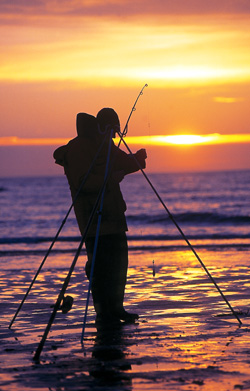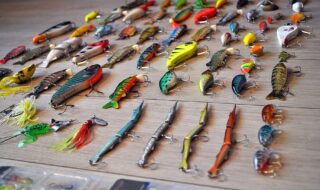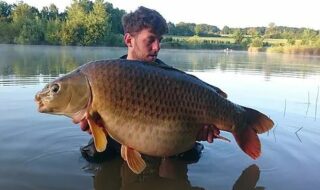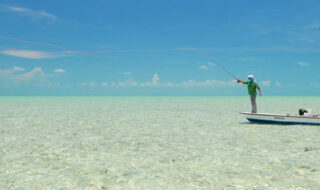If you want to catch more from the beach then read on as Total Sea Fishing reveals 10 top tips that are sure to improve your chances this season.
COD are the most common target species along the UK coastline and every year anglers travel to their favourite venues in their masses to try for that elusive ‘big one’.
However, the harsh reality is that the big fish scenario is rapidly becoming a thing of the past with less and less large fish being caught. But don’t despair because as each year goes by, and with the decrease in commercial fishing, the smaller codling seem to be making something of a comeback.
It is possible to catch cod all year round but in the warmer summer months it is usually only the rough, kelp-strewn ground that will hold them in any sort of numbers. These fish are usually a deep red in colour after spending many weeks in among the kelp.
Winter is undoubtedly the best time to target cod. It’s at this time of year when bait fish such as sprat and herring have moved on to warmer waters, leaving the cod searching for their next available meal. And the only place that food will be readily available is close inshore.
The water close to the shore usually provides a safe haven for many small marine creatures such as crabs, prawns and small, vulnerable fish. But when the wind blows off the sea and onto the shore these small creatures can’t cope with the turbulent waters and are washed out into open water where the cod are waiting to feed.
The cod know the seas better than any angler ever will and they’ll be waiting where the food is readily available. So, if you want to catch cod this winter you need to be one step ahead of the fish.
We can’t wave the magic wand and tell you exactly where the fish will be, but we can give you a load of tips that will undoubtedly increase your chances this winter.
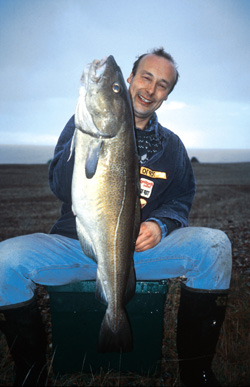 |
| Cod will eat almost any of the standard sea baits. |
Tricky Cod
The first thing to know when fishing for cod is about the fish and its habitat, because an understanding of your quarry’s habits goes a long way towards being a successful angler.
Cod are a shoal fish and can sometimes be found in large numbers, with a single session producing tens of pounds of fish. But the secret is to know when and where they are going to show.
They more often than not turn up at the same stage on each tide, sometimes only for an hour or so. This makes it essential to have local knowledge to determine which tide will produce the best catches and at what particular stage of the tide a run will be anticipated.
The trick here is to get to know the venue yourself, which can take several years of trial and error, or ask the local tackle dealer for advice as well as a few regulars to the beach. Listen to what people tell you and never shrug off the advice, these are the people who know more about the venue than anyone else. Yes, you will at times get duff info but it’s all down to trial and error.
Arming yourself with enough information about the area will increase the chances of you turning up at the correct time on the beach – when the cod are there.
Hooked On Bait
The cod’s main food source during the winter months is pretty much anything that is edible, which includes fish, crabs, shellfish, shrimps, prawns, razor fish, lugworm, ragworm, squid and so on. They have a mouth that in fact equals their appetites as well, so there are no worries with regards to a bait being too big for them.
However, for clean beach fishing, lug, squid and crab are the most effective baits, either on its own or mixed together as a cocktail. With these baits it can pay to go large, simply because the bigger the bait the larger the scent trail will be. It can also pick out the bigger fish when you are plagued with undersized fish.
The top winter bait is usually lugworm, which is tipped off with crab or squid.
The best way to make this bait large enough and more attractive to the fish is by threading a single worm on, as usual, and then head-hooking three or four more. Now lay the head-hooked worms along the already threaded-on worm and use elastic to attach the head-hooked worms to it. What you end up with is a thick sausage of worms. Then simply tip-off with a piece of crab or squid, securing that on with elastic, too.
For this bait it is essential to use large hooks. In fact, cod would have no problem in swallowing a pair of size 6/0 hooks on a Pennell-type rig. Using hooks of this magnitude makes it a lot easier to build a suitably-sized bait because smaller hooks would simply become buried in the bait – rendering them useless.
|
|
||||
|
|
Right Rigs For Cod
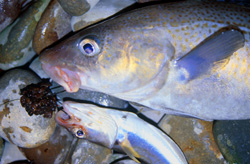 |
| Use short snoods in fast tides and shallow water. |
The best rigs for targeting cod from a clean beach is either a single snood Pennell flapper or a single snood Pennell clipped-down.
Which one to choose depends on how far out the fish are. The further out they are makes it more important to streamline the rig for aerodynamics and the clipped-down will definitely travel further than a flapper.
There are two rules of thumb to follow when considering snood lengths, and these are to use short snoods in shallow water or in fast-flowing tides, and long snoods at deepwater venues or in slow-moving tides. This will give you far better bait presentation and ensure that the bait is hard on the bottom where the fish are feeding.
The reasons for this are simple because long snoods tend to tangle in shallow water and also a fast tide will lift the bait off the sea bed. Short snoods around 8in, however, will stay nearer to the sea bed in fast tides and do not tangle in shallow water.
So, find out what the beach is like before you go and adjust your hook accordingly. Sometimes something as simple as snood length does make the difference between bagging up and blanking!
Another rig worth a try is the wishbone. It is constructed much the same way as the single snood Pennell but rather than the two hooks laid along the snood, the wishbone has its hooks laid alongside each other.
The wishbone is great for fishing two different baits just a few inches apart, which is a great technique that is used to determine what bait the cod are more interested in on that particular day.
Liven It Up
More often than not the cod come in to gorge on a food source that has become available close to the shoreline. Quite often this will mean that the cod will be searching for small fish such as whiting and pouting, which instantly tells us that these small fish will make great baits, too.
When you suspect that the cod are feeding on other small fish you can put this feeding frenzy to your advantage. There are two ways to do this but much depends on how far out you want to put the livebait.
For close-range fishing, it’s far easier to take another rod to the beach and use that to catch your whiting and pouting etc. You can then keep them alive in a bucket with an aerator and use them when required. The best thing about keeping them alive with an aerator is that any fish you don’t use can be safely returned to the sea.
The second option when the cod are feeding at long range, is to catch the livebait at the same range and leave it there until a cod comes along. However, you will have to change to a livebait rig to do this.
A livebait rig is almost identical to a Pennell rig but instead of using similar-sized hooks, you use a small size 1 or 1/0 on the bottom and a larger 4/0 or 6/0 hook above it.
Bait the small hook with a single worm bait and cast out as usual. Then, all you have to do is watch the rod tip for a rattle as a whiting takes the worm. Do NOT reel in, simply leave the whiting on and wait for a hungry cod to come along and swallow it down.
The technique does work extremely well and is especially useful for targeting the larger specimens.
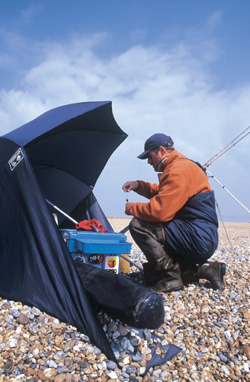 |
| A beach shelter – a vital piece of kit. |
Under Cover
Winter fishing of any sort usually means bad weather and staying warm and dry will undoubtedly make the experience far more enjoyable. It also ensures that you stay on the beach for longer, which could coincide with a good run.
When fishing a clean beach it usually involves a shingle or sandy shoreline, so there is no excuse for you not to take a beach shelter of some kind.
Setting one up only takes a few minutes where ground like this is involved and the benefits far outweigh the time taken to put it up.
There are many reasons for using a beach shelter, not only as some form of cover for protecting yourself from the elements but is also important to keep your bait and captured fish in the best possible condition.
Keeping the bait out of direct sun, rain or wind will prevent the worms from ruining rapidly. It also ensures that it stays fresh and therefore retains its attractive scent for longer.
For keeping the fish fresh it is best to have a bucket of sea water to keep them in. This, combined with putting the bucket under the cover of the shelter, will certainly keep the fish fresher for the table.
Get A Feel
The very nature of clean beach fishing suggests that there are no features such as rocks or broken ground to fish to. So you are probably wondering what is going to attract the fish if the sea bed is so featureless.
The answer is simple. Most sand or shingle beaches will have areas where the sea bed has either washed away to form a depression or where sand has built up to form a series of sand bars and gullies. It is these areas that hold food items and worm beds, which will be a typical patrol route for the cod.
To locate these sea bed features there is a very cunning trick to use. Simply cast a plain lead out to sea as far as you can and retrieve the lead slowly. As you retrieve the line you will be able to feel the lead dragging up the sides of any sand bars as well as dropping into gullies. As the lead falls into a gully, it will feel like the lead has momentarily gone weightless.
Now, all you have to do is pay attention to each time the lead reaches something, stop reeling and make a mental note of how much line there is on the reel. This will give you an idea of how far to cast when locating the features and hopefully put the bait where the fish are feeding.
Leads To Bites
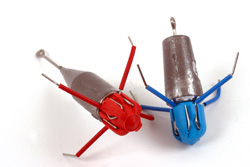 |
| Use thick grip wires if fishing on a sandy beach. |
Lead choice is also important when it comes to getting the bait out to where the fish are and with the relative size of bait.
If you are using large bait you will need a heavy lead such as a 175g or 200g lead to tow the bait and line out to where the fish are. If it is only a little bait such as a single worm, then a normal 150g lead will do, because the bait gives less resistance during flight and is lighter for the lead to tow.
The only other consideration is holding the bottom and with a sandy sea bed it is necessary to use thick grip wires so that more resistance can be given from the wires as the tide tries to break it free. A good option is to use sections of tubing, such as rig tubing over the wires to increase their diameter and therefore grip.
When a fish takes the bait, the bait may show in two different ways. The first is a heavy thumping on the rod tip and then the line going slack as the cod pulls the lead free. The second is sometimes only a little rattle but more importantly the line suddenly going down tide as the fish swims away.
This is why it is important to make sure that the bait is securely anchored to the sea bed, not only for bait presentation but for bite indication too.
Tackling Up
The choice of rods and reels will greatly depend on how far you need to cast. If the area holds the cod close in, then any standard beachcaster will do, whereas if the fish are at range a more powerful rod will be needed – one that is capable of casting a large lead and heavy bait a long way if necessary.
As for the reels, well there isn’t a lot to choose between any of the modern fixed spool reels and multiplier reels. So go for whatever reel you feel comfortable with.
However, if you plan to spend time fishing into darkness and you are new to the multiplier reel market then we would strongly recommend that you stick with a fixed spool reel for this type of fishing. It will ensure that you have little or no problems with casting and ensure that the session is enjoyable.
When it comes to lines, it is recommended that you use a running line of no less than 15lb breaking strain because a good-sized cod can really pull hard and make short work of weaker lines, especially in the surf.
Also use a suitable shockleader. If you are using any sort of power casting then it is recommended that you use a shockleader of around 70lb-80lb. But for other styles you will get away with 10lb of leader for every ounce of lead that you use. So, if you are using a 5oz lead use a 50lb leader or if it’s a 6oz lead use 60lb.
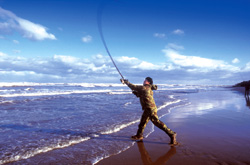 |
| The best time to fish is when the sea is calming down following a storm. |
Roughing It
Most anglers would at some time have heard the expression: ‘it always fishes better after a blow’. Well, in most cases this is very true.
What actually happens is that during a storm, or rough sea conditions, the sea bed gets stirred up and all the feed in it slowly gets washed out, which to a cod means dinner is served!
If you are brave enough to battle the elements during a good blow, then you are likely to get good results, but the best time to approach the beach is just when the sea and weather begin to calm down, because more time will have passed meaning that there is a good chance that more fish would have arrived for the feast.
Be aware that these conditions present many problems for the anglers, such as strong tidal flows and floating debris. These can take their toll on weaker tackle, so be prepared by making sure that your rods, reels and lines will cope with these given scenarios.
10 Conservation Please
Cod are best associated with being coupled with a big plate of chips but, unfortunately, due to heavy commercial fishing pressure, the larger cod are rapidly disappearing from our shores. Therefore, a bit of common sense doesn’t go amiss here and you should only take what fish you require for the table. It’s also important to remember that it is the larger cod that form the breeding stock and returning these fish will increase the chances of sustaining our cod fishing.
This way, we as anglers can say that we are doing our little bit towards conserving our mighty cod and its ever-decreasing size and numbers. If we want future generations to enjoy what we have, then it is now time to do something about it because if we carry on the way we are going there will be no cod left to fish for.
You should also remember the legal minimum size limit for a shore caught cod, which is currently set at 35cm. Any fish below this size should be carefully returned to the sea.


